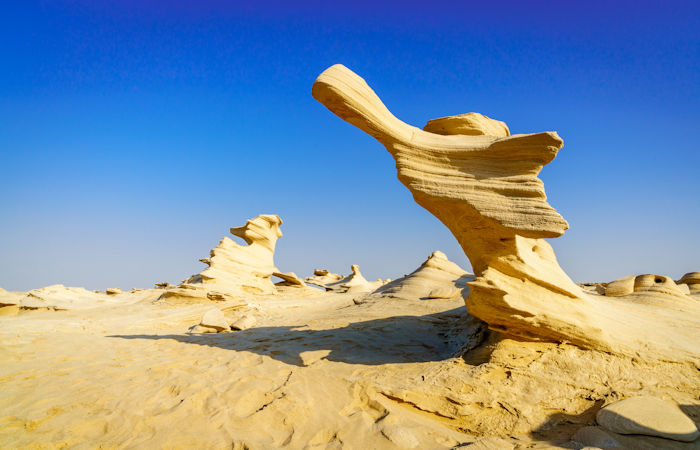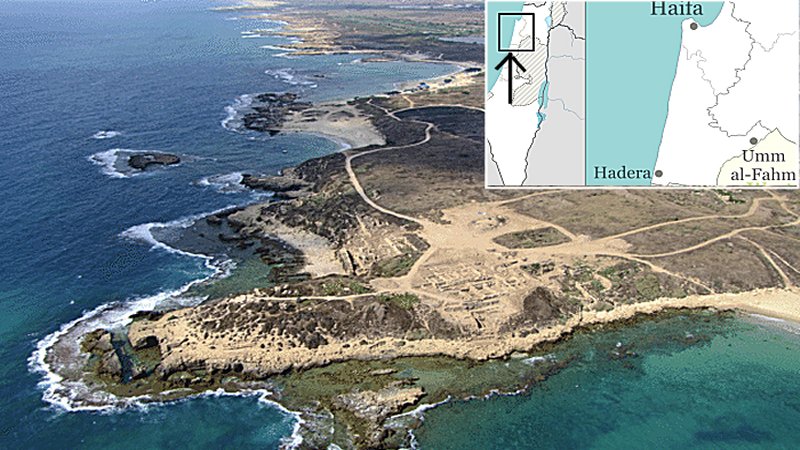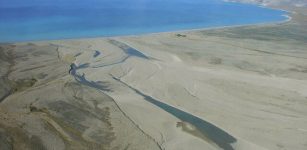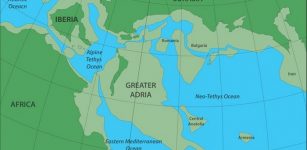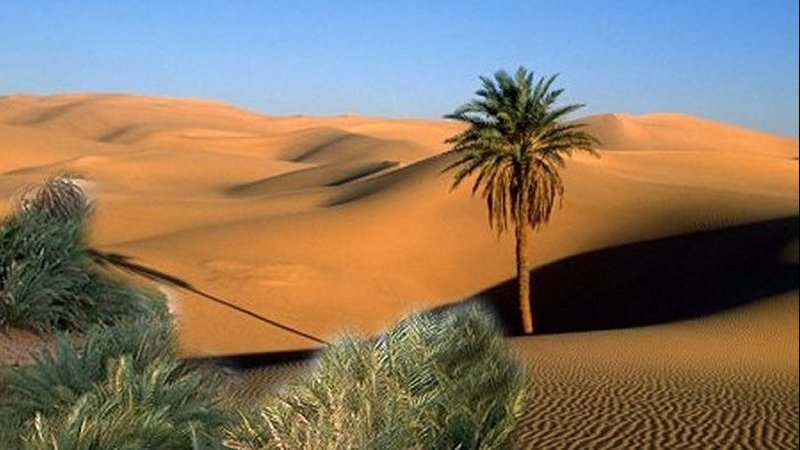Abu Dhabi Fossil Dunes May Have Inspired The Ancient Great Flood Story – Professor Says
Jan Bartek – MessageToEagle.com – Located not far from the international airport, the Al Wathba region is home to a beautiful oasis-like wetland reserve that is enjoyed by flamingos.
The Al Wathba oasis in Saudi Arabia hosts 50 species of flora native to the region across an area of 50,000 sqm. It is also a sanctuary for wildlife and a place where we find fossil dunes formed over thousands of years.
Sandstone structures (fossil dunes). Al Wathba. Credit: Adobe Stock – jaleel
The Great Flood has long been a heated subject among scientists and the public. Many people associate the story of the Great Flood with the Bible.
“However, ancient cultures all across the world have myths and legends describing a time in the distant past when a horrifying Deluge wiped all almost all life on Earth. The story of Noah’s ark is not just a Biblical story. Noah was known under a different name in India, among ancient Egyptians and Native Americans, just to mention a few cultures.” 1
Underwater archaeologists have searched for traces of an ancient lost civilization that could reveal more information about the Deluge. One scientist says he has discovered evidence indicating that the ancient city of Petra was destroyed by a Great Flood.
“There is evidence that Petra survived a devastating earthquake that many thought had destroyed the city. According to Dr. Thomas R. Paradise, a geoscience professor at the University of Arkansas, the ancient city of Petra was destroyed by a Great Flood in the 4th century. Professor Paradise has conducted research in Petra since the late 1980s, and he is convinced traces of white sand found in the rubble offer proof of massive flooding that forced the city’s inhabitants to abandon their sacred and precious site.
How did white sand end up in a valley exclusively of red rock? Professor paradise says the white sand does not belong there.” 2
Thomas Steuber, a professor in the Earth Science Department of Abu Dhabi’s Khalifa University of Science and Technology, has spent much time examining Al Wathba’s impressive fossil dunes.
In an interview with CNN, he explained the story behind the fossil dunes is more complex than most realize.
Ass reported by CNN, “Abu Dhabi’s Environment Agency dates the fossil dunes at between 120,000 and 150,000 years old. Steuber says that generations of dunes were created by cycles of ice ages and thaws that occurred between 200,000 and 7,000 years ago. Ocean levels dropped when frozen water increased at the polar caps and during these drier periods, dunes would’ve built up as sand blew in from the drained Arabian Gulf.
When the ice melted, leading to a more humid environment, the water table rose in what is now Abu Dhabi and the moisture reacted with the calcium carbonate in the sand to stabilize it and then form a kind of cement, which was later whipped into ethereal shapes by prevailing winds.
“The Arabian Gulf is a small basin that’s very shallow,” says Steuber. “It’s only about 120 meters deep, so at the peak of the ice age, about 20,000 years ago, there was so much piled up on the polar ice caps that water was missing from the ocean. That meant the Gulf was dry and was the source of material for the fossil dunes.”
Steuber says similar sand dunes can be found in India, Saudi Arabia and the Bahamas. The problem with these natural creations is that “despite the official protection now offered in Abu Dhabi, the erosion that gave each its unique shape will also eventually lead to their demise.
Fossil dunes, Al Wathba. Credit: Adobe Stock – Alexey Stiop
“Some of them are quite massive, but in the end the wind will destroy them. They are essentially rocks, but you can sometimes break them with your hands. It’s quite a weak material.”
Professor Steuber also says, “the dunes could be evidence of the inspiration behind the tale of Noah’s flood, which features in the Koran, the Bible and the Torah, the texts of the three major religions to emerge from the Middle East.
“Possibly, this was the flooding of the Arabian Gulf at the end of the ice ages, because the sea level rise was very rapid.
“With a dry Arabian Gulf, the Tigris and Euphrates rivers would’ve discharged into the Indian Ocean and what is now the Gulf would have been quite a fertile low lying area which 8,000 years ago would’ve been inhabited, and people may have experienced this rapid sea level rise.
“Perhaps it led to some historic memory that made the holy books of these three local religions.”
Written by Jan Bartek – MessageToEagle.com – AncientPages.com Staff Writer
Expand for references

